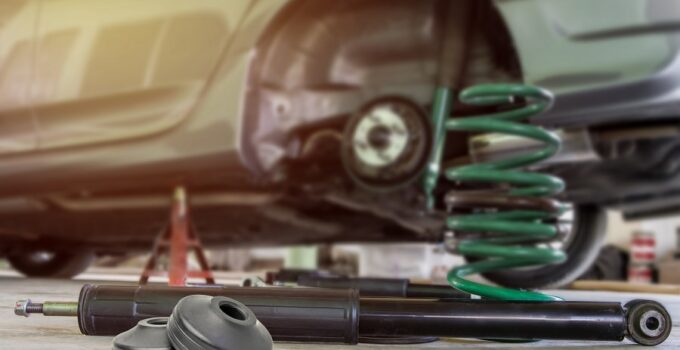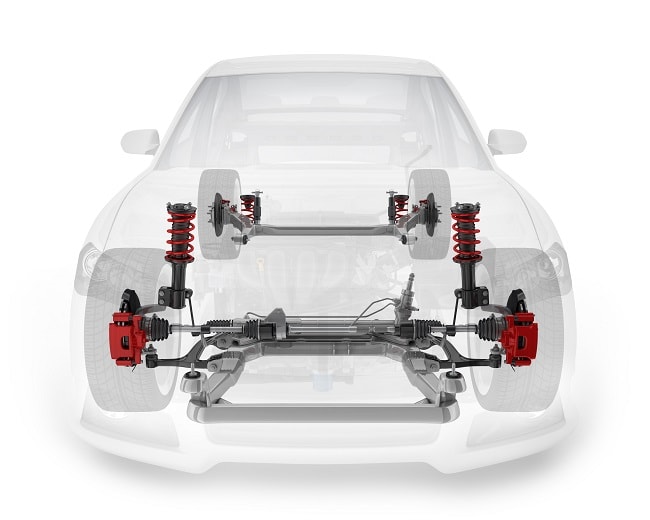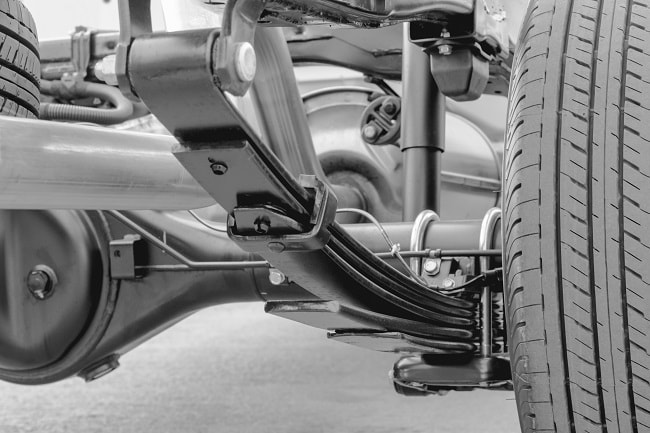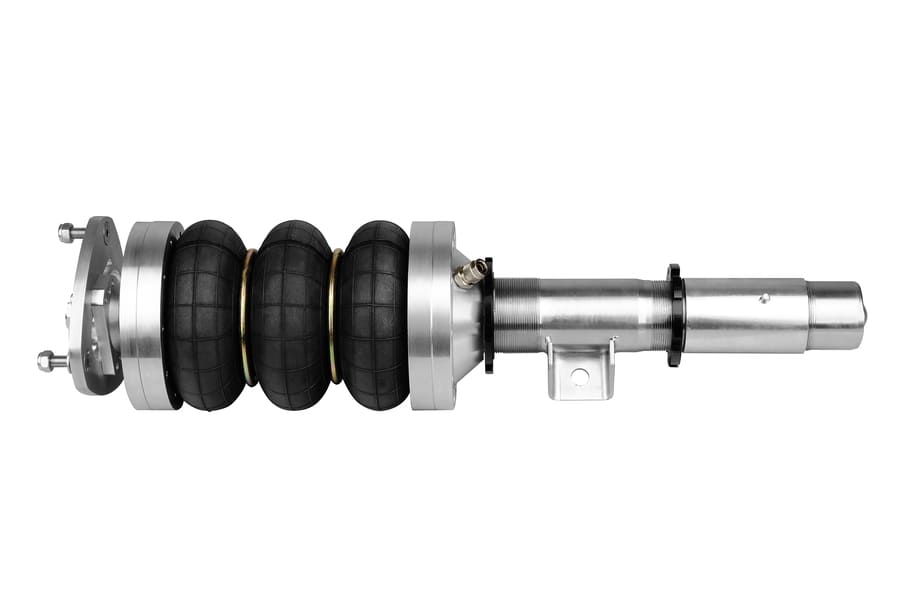
The wheel suspension or chassis is the connection between wheel and vehicle. A few elements have a decisive influence on driving behavior. These primarily include the spiral springs, the shock absorbers, the stabilizers and the wishbones. The wheels are guided primarily by wheel bearing carriers, wishbones, wheel bearings, etc. Furthermore, the entire chassis also includes support bearings and the bump stops, but also the tires and the wheels.
Contents
What is the purpose of the car suspension?
The suspension itself provides a moving connection between your wheels and your vehicle. Their purpose is to allow you to travel as safely as possible. In addition, any problems with comfort on poor road surfaces should also be reduced. In addition to impact reduction, this also includes mitigating noise and vibration transmission. To do this, your wheel suspension must primarily dampen vibrations, transmit steering movements and be able to track the wheels elastically (suspension) in the event of impacts. In addition, it is also particularly important to make the wheel suspension as light as possible in order to keep the unsprung mass of your car as small as possible.

What types of wheel suspension are used?
There are a number of different types of wheel suspension. The classic is the so-called rigid axle. In this variant, a rigid axle bridge connects the two wheel carriers on both sides of the vehicle. As a result, the axle housing can fail, which is commonly referred to as an axle breakage. The type described was already in widespread use in the 1930s. In the meantime, however, you can find a so-called independent wheel suspension in many vehicles.
What are the characteristics of rigid axles?
The first rigid axles were made with the help of two leaf springs, which were mounted lengthways. At the same time, a joint was used for one side of the leaf spring in order to create a longitudinal rocker. If you brake or accelerate your vehicle with this type of wheel suspension, the leaf spring deformation will be S-shaped. These types of axles are primarily found on off-road vehicles and trucks these days.

Independent suspension
This designation comes from the fact that with this wheel suspension structure, all wheels are guided independently of one another. This also means that the positions of the individual vehicle wheels are independent of one another. This facilitates the steering in particular. On the front axle, wheel suspensions with links, spring strut wheel suspensions, swing axles or so-called swing arms, such as the Dubonnet spring knee, are primarily used. The types of wheel suspension with links include multi-link axles, triangular link axles, crank link axles and double wishbone suspensions. In the area of the rear axle, you will primarily find swing axles, trailing arm axles, semi-trailing arm axles, double wishbone axles, sword-arm axles and multi-link axles. Cars nowadays almost exclusively have independent wheel suspensions in different designs. Because the individual wheels are cushioned and dampened independently of one another, you need the trailing arms, wishbones, trailing arms and multiple links already described.

How is your wheel suspension built?
Basically, there is a so-called wheel carrier for each individual wheel on your vehicle, which in turn is usually made up of a wheel hub and wheel bearing. With a drive axle there is of course still a drive shaft connection, whereas non-driven vehicle wheels still have an integrated wheel brake. With drive axles, on the other hand, the braking torque is transmitted with the help of the drive shaft. In this way you can downsize the structure and also reduce the unsprung vehicle mass. Your wheel suspension also includes shock absorbers, links, joints and springs.
What is meant by hydropneumatic and pneumatic suspension?
Classic spiral springs are often used as suspension in passenger cars. In the case of particularly high-quality vehicle variants, on the other hand, you will also find air suspension. The latter is characterized in particular by a soft response, which allows a significantly higher driving comfort. In addition, such a system can also be electronically influenced in its properties with the appropriate equipment. This allows, for example, a load-independent level control and an adjustment of the existing preload. Ultimately, this allows you to adapt your chassis to your desired properties and driving style.
The term pneumatic suspension means nothing more than that it is a so-called air suspension. This type of suspension is mostly reserved for premium vehicles or trucks. However, this is not a system that is used very often. Nevertheless, there are already models from the 1950s which were equipped with pneumatic suspension. This comfortable type of suspension has faced competition in particular from the development of the so-called hydropneumatic suspension. City buses often have pneumatic suspension. Most people have experienced this before, because when stopping, the bus driver often lowers the side of the vehicle that faces the sidewalk/bus platform. To do this, the air is simply released so that the bus lies on the metal springs. This process, called kneeling, allows the passengers to board much more comfortably.

For example, a hydropneumatic suspension was developed by the French brand Citroen. The vehicle manufacturer combines air suspension with suspension using hydraulic fluid. This is usually a hydraulic oil. The system is designed in such a way that a defined amount of nitrogen is introduced into a steel container. The hydraulic oil is separated from the gas by a corresponding membrane. This is primarily used for power transmission. The gas phase is therefore responsible for the suspension. In contrast, the hydraulic oil has the additional task of acting as a damper for the wheel suspension. Due to the low mechanical friction and the quick reaction of damping and suspension, this allows a particularly high level of driving comfort.
Conclusion
There is a large number of different wheel suspension variants. While today independent wheel suspensions are mainly found in the area of the steered front axle, there are still some rigid axles or semi-rigid axles in the area of the rear wheels. In addition to the classic suspension with spiral springs, there are also bodies with pneumatic suspension or hydropneumatic suspension.
A tip from CarTipsandmore:
- Stepping frequently in the area broken springs, worn shock absorbers or damage to the wishbones. Inexpensive complete sets of tie rods, wishbones, coupling rods, wishbone bearings, ball joints and ball joints are often offered for wheel control. Since all of these components wear out at a similar rate and the amount of work involved in replacing all of the components is only slightly greater, you should replace them together.
- After working on your wheel suspension, particularly in the area of wheel guidance, readjustment of the track is unavoidable . This should always be carried out by a specialist company. If you discover further problems, these should be eliminated immediately in order to avoid expensive consequential damage.
